明亮白光对妇科癌症患者疲劳水平的影响:一项随机对照试验。
IF 1.3
4区 医学
Q4 HEALTH CARE SCIENCES & SERVICES
Journal of Palliative Care
Pub Date : 2023-10-01
Epub Date: 2022-09-25
DOI:10.1177/08258597221127795
引用次数: 0
摘要
目的:亮白光(BWL)疗法是治疗疲劳的非药物方法之一。本研究的目的是评估BWL对正在接受化疗的妇科癌症患者疲劳水平的影响。方法:对妇科肿瘤门诊的72名女性(干预组(n=36)和对照组(n=36)进行随机对照研究。在化疗周期的第二天到第八天之间,每天在同一时间对干预组的患者应用强度为10000lux的标准BWL。在第1天、第9天和第21天评估所有患者(n:72)的疲劳水平。结果:干预组和对照组的第1、9、21天一般疲劳评分为4.876 ± 0.000;4.384 ± 0.270;4.387 ± 0.258和4.876 ± 0.000;5.033 ± 0.270;4.984 ± 分别为0.258(p = 0.100)。在第一天、第九天和第21天,干预组和对照组的疲劳对日常生活得分的干扰存在统计学差异,分别为4.55 ± 0.26;3.53 ± 0.23;3.57 ± 0.22和4.95 ± 0.26;4.79 ± 0.23;4.82 ± 0.22(p = 结论:BWL治疗能有效减少化疗患者疲劳对日常生活的干扰,但不影响患者的整体疲劳水平。根据现有数据,当样品数量和应用时间增加时,BWL的应用可能对一般疲劳产生积极影响。试验注册:ClinicalTrials.gov标识符:NCT05009693。本文章由计算机程序翻译,如有差异,请以英文原文为准。
The Effect of Bright White Light on Fatigue Levels in Patients with Gynecological Cancer: A Randomized Control Trial.
Objectives: Bright white light (BWL) therapy is one of the non-pharmacological methods in the management of fatigue. The aim of the study was to evaluate the effect of BWL on fatigue levels in patients with gynecological cancer who were receiving chemotherapy. Methods: This randomized controlled study were made with 72 women (intervention (n:36) and control (n:36) groups) at gynecologic oncology clinic. Standard BWL at the intensity of 10,000lux was applied to the patients in the intervention group at the same time every day between the second and the eighth days of the chemotherapy cycle. Fatigue levels of all patients (n: 72) were evaluated on the first,ninth and 21st days. Results: The first, ninth, and 21st days general fatigue scores of intervention and control groups was 4.876 ± 0.000;4.384 ± 0.270;4.387 ± 0.258 and 4.876 ± 0.000;5.033 ± 0.270;4.984 ± 0.258, respectively (p = 0.100). Interference of fatigue with daily life scores was found statistically different between the intervention and control groups in the first, ninth, and 21st day, respectively 4.55 ± 0.26; 3.53 ± 0.23; 3.57 ± 0.22 and 4.95 ± 0.26;4.79 ± 0.23;4.82 ± 0.22 (p = 0.029). Conclusions: BWL therapy was effective in reducing interference of fatigue with daily life in patients receiving chemotherapy, but did not affect the general fatigue level of the patients. Based on the available data, it is possible that the application of BWL may have a positive effect on general fatigue when the number of samples and the application time are increased. Trial Registration: ClinicalTrials.gov Identifier: NCT05009693.
求助全文
通过发布文献求助,成功后即可免费获取论文全文。
去求助
来源期刊

Journal of Palliative Care
医学-卫生保健
CiteScore
3.20
自引率
5.90%
发文量
63
审稿时长
>12 weeks
期刊介绍:
The Journal of Palliative Care is a quarterly, peer-reviewed, international and interdisciplinary forum for practical, critical thought on palliative care and palliative medicine. JPC publishes high-quality original research, opinion papers/commentaries, narrative and humanities works, case reports/case series, and reports on international activities and comparative palliative care.
 求助内容:
求助内容: 应助结果提醒方式:
应助结果提醒方式:


